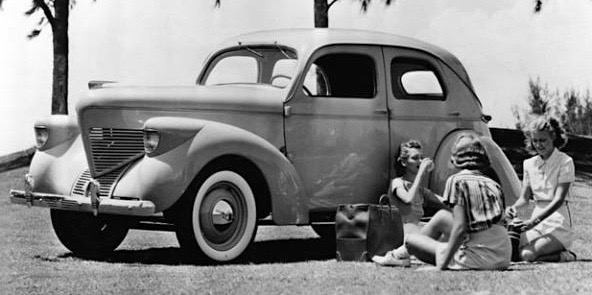I touched on the matter
here, and am now expanding on it. Many automobile models have variations in price and prestige. For example, my own model comes in three trim varieties, mostly having to do with the interior. From the outside, these varieties are distinguished by the type of wheels and a few letters attached to the trunk lid.
At the other extreme, back in 1950s America during the fashion of elaborate two and even three color paint schemes and variations in chrome trim, the top and bottom of a brand's line were often easy to distinguish. Despite my academic degree field, I'll do my best to avoid committing an act of sociology (being an apostate) to explain this. From a strict automobile styling standpoint, the 50s was a time shortly after a strong, evolutionary trend had ended and styling staffs were groping (and failing to find) another evolutionary path. See my book "Automobile Styling" for more detail.
This business of creating distinctions of price/prestige is a tricky one for manufacturers. On the one hand, many buyers of top-of-the-line models enjoy being able to show off that they bought the best of the lot. On the other, buyers of lesser models might feel a little unhappy that that other people can notice that their car isn't top-drawer for the brand. So a certain amount of care needs to be taken to avoid loss of sales at either end of the continuum. Of course, many buyers are not snobbish in this way; some are utilitarian in outlook and buy the model that best fits their budget and practical needs.
In today's automobile world, models of differing design within brands are what serve as price/prestige indicators. Examples are letter-series Mercedes and number-series BMWs.
Returning to 1950s America, here are some examples of strong differences between models (though I must note that many brands' trim differences were more modest than what is shown below).
Gallery
1950 Chevrolet Styline Special Sport Coupe (for-sale photo). Bottom of the line. Exposed rubber windshield moldings and rubber rock guards on the rear fenders. The chrome strip running along the top of the rear fender hid a cut-line, the fender panel being detachable on 1949 and 1950 Chevys.
The top of Chevrolet's 1950 line, the Bel Air hardtop (Barrett-Jackson photo). Much more chrome trim can be seen here, though it isn't very gaudy.
1952 Ford Mainline Tudor. Bits of rubber here and there like the Chevy shown above. The only chrome trim on the sides is along the belt line.
The Customline Fordor. Not much chrome, but enough to distinguish it from the almost totally-plain Mainline series.
1951 Hudson Pacemaker (for sale photo). A thin chrome strip low on the body is the main bright side decoration.
The '51 Hudson Hornet in this for-sale photo features a chrome strip echoing the pressed character line along with a wide swath of chrome along the lower edge of the body.
1955 Chrysler Windsor DeLuxe Nassau hardtop, Mecum Auctions photo. We are now well into the era of elaborate paint jobs set off by chrome trim. But this entry-level hardtop lacks all of that.
Top of the line '55 Chrysler New Yorker DeLuxe St. Regis hardtop. Aesthetically a few notches down from the Windsor, though it follows the function of proclaiming what it is. Interestingly, the first Chrysler 300, introduced partway into the model year, had a clean side like that of the Windsor in the previous photo.
1955 Chevrolet One-Fifty Utility Sedan (for sale). During the era of 1950s excess, we find this almost totally plain automobile.
1955 Chevrolet Bel Air hardtop at the other end of the line (Auctions America photo).
1956 Nash Rambler Super. It isn't nearly as plain as the Chevy One-Fifty, having a swoopy two-tone paint scheme. But it isn't nearly as elaborate as...
... the three-tone paint job on the line-leading Rambler Custom 4-door hardtop.
Finally, a 1958 Chevrolet Delray coupe. Two-tone paint schemes were possible due to the chrome strip running along much of the side, though this car has only one color. The color break at the front was via a small chrome piece linking the side strip with the top of the wheel opening. This car lacks it, being monochrome.
This Bel Air sedan shares the side body stampings with the Delray, but uses a different trim design to proclaim its higher status. It has the forward color divider above the wheel opening.

























































